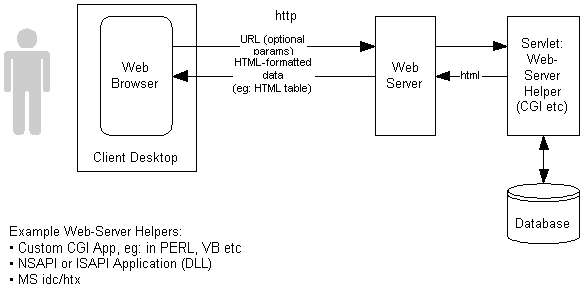Last edit: 05-03-17 Graham Wideman
| Last edit: 05-03-17 Graham Wideman |
Models |
| Web-Database Models Article created: 97-??-?? |
Assorted models for database access via web mechanisms.

Examples:
Examples:
Implemented in PERL, C, VB etc
A: Servlet understands particular flatfile formats
B: Servlet has driver(s) for local database
C: Servlet can interact with local or remote SQL database servers, either through native
drivers, or via ODBC
D: Similar to C, except the complete kit includes database stored procedures to generate
html documents (eg: Oracle WebServer).
MS HTX/IDC and MS ASP mechanisms are both varieties of B and C using Query Spec documents. The main difference between HTX/IDC and ASP is that the former implements a simple and limited specification language, while ASP allows inclusion of Basic code to be executed by the ASP web-server-helper mechanism in making the query and composing the returned HTML document.
Examples:
Examples:
Examples:
Note: This is essentially "auto-installing database-Client/Server". The SQL connection may or may not require a "connection" component (like SQL*Net). JDBC drivers may cover this function.
Examples (of this particular 3-tier breakdown):